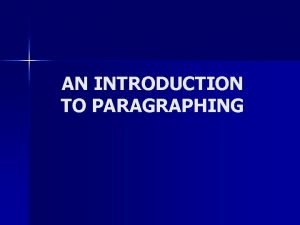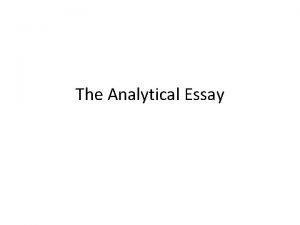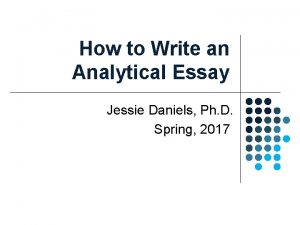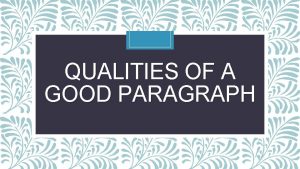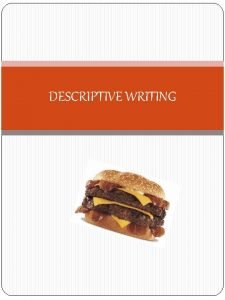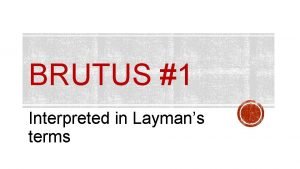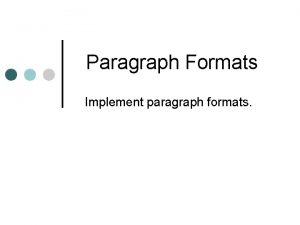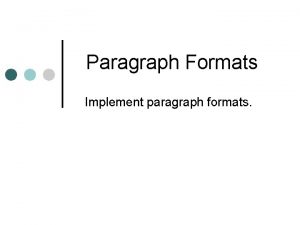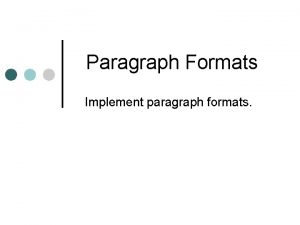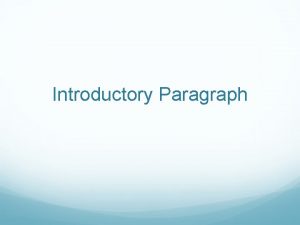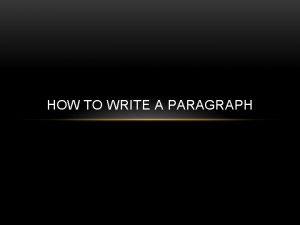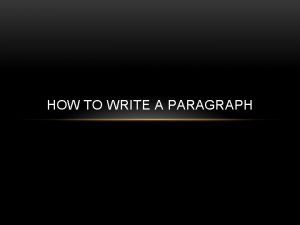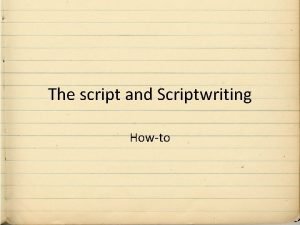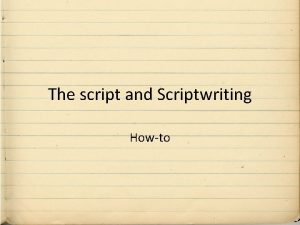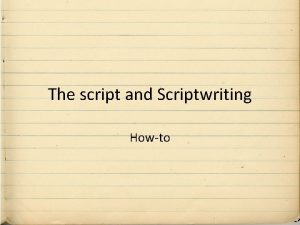analytical paragraph A howto guide In an analytical














- Slides: 14

analytical paragraph A how-to guide

• In an analytical paragraph a writer analyzes a particular topic and breaks it down into logically flowing sentences. • This is the backbone of how you respond “critically” to literature and history. • It is how we’ll attempt to "explain, argue and persuade" in English 8. What is it?

For your analytical paragraph you’ll need: 1. Topic Sentence (TS = what the paragraph will be about) 2. Concrete Detail (CD = fact, statistic, quote, evidence, support) 3. Commentary (CM = 2 commentary sentences per CD) 4. Concluding Sentence (CS) How do I write one?

Follow these steps: 1. 2. 3. 4. Create a topic sentence (TS) Introduce your evidence (CD) Comment on/Analyze your evidence (CM) Create a closing/transitional sentence (CS) Say what?

Question/Prompt: Choose one of the main characters (Billy or the landlady) and write about their most important, strongest or weakest trait. example

• Billy’s weakest trait was being too trusting. Step 1: topic sentence

Billy’s weakest trait was being too trusting. One example of this is that Billy initially senses that the landlady is a bit dotty or strange. Step 2: Introduce evidence – this is the “what” sentence and is a fact that shows “what” your “proof” will be. It should be either facts, examples, evidence, support, quotes, paraphrases, etc. It should be a concrete detail and often starts with a transition.

Billy’s weakest trait was being too innocent and trusting. One example of this is that Billy initially senses that the landlady is a bit dotty or strange. This shows that although Billy feels something is off in regards to the landlady he still foolishly trusts her enough to rent a room. Step 3: commentary sentence – where you comment on/analyze your evidence. This sentence contains no facts but is a comment from you, the writer, about the fact presented in the CD. This is where the writer (you) explain how the CD helps prove your point (TS).

• Billy’s weakest trait was being too trusting. One example of this is that Billy initially senses that the landlady is a bit dotty or strange. This shows that although Billy feels something is off in regards to the landlady he still foolishly trusts her enough to rent a room. This is important because Billy’s trusting nature leads to his downfall at the hands of the sinister landlady. Step 4: 2 nd commentary sentence (CM) – this additional commentary helps prove that your evidence (CD) proves your point (TS). *There will be 2 CM for each CD in your paragraph!

Billy’s weakest trait was being too trusting. One example of this is that Billy initially senses that the landlady is a bit dotty or strange. This shows that although Billy feels something is off in regards to the landlady he still foolishly trusts her enough to rent a room. This is important because Billy’s trusting nature leads to his downfall at the hands of the sinister landlady. Therefore, trust is a great quality to have but one must always trust their instincts as well. Step 4: concluding sentence – wraps up your TS and sums up your paragraph. Gives insight into next paragraph if appropriate.

Billy’s weakest trait is that he is too trusting. One Topic Sentence example of this is that Billy initially senses that the Introduce Evidence landlady is a bit dotty or strange. This shows that although Billy feels something is off in regards to the Comment landlady he still foolishly trusts her enough to rent a on/Analyze room. This is important because Billy’s trusting nature leads to his downfall at the hands of the sinister landlady. evidence Therefore, trust is a great quality to have but one must Concluding always trust their instincts as well. Sentence analytical paragraph - diagrammed TS – CD – CM - CS

TS – CD - CM - CS That’s great, but does it work for more complicated questions?

How does Shakespeare approach the concept of fate in Romeo and Juliet? Question:

Shakespeare makes fate a central concern for the characters in Topic Sentence Romeo and Juliet. As early as in the prologue, the chorus says “from forth the fatal loins of these two foes. ” “Fatal loins” Concrete Detail indicates that the conflict of the parents will be passed to Comment on/Analyze Romeo and Juliet through birth. As such, they are destined, or evidence (2) fated, to have trouble. The prologue continues with “a pair of star-cross’d lovers take their life. ” Here, “star-cross’d” refers Concrete Detail Comment on/Analyze to the ancient belief that the heavens directed the order, or path, of people’s lives. In other words, they are fated by God. evidence (2) By its early and frequent mention in Romeo and Juliet, fate is Concluding Sentence revealed to be an important theme in the play. TS – CD - CM – CS YES!
 Formula of gdp
Formula of gdp Samba-tool domain provision
Samba-tool domain provision Analytical paragraph writing
Analytical paragraph writing Analytical paragraph example
Analytical paragraph example Analytical paragraph writing
Analytical paragraph writing 5 point rubric for essay
5 point rubric for essay![Whose “great days [are] like ghosts gone”? Whose “great days [are] like ghosts gone”?](data:image/svg+xml,%3Csvg%20xmlns=%22http://www.w3.org/2000/svg%22%20viewBox=%220%200%20200%20200%22%3E%3C/svg%3E) Whose “great days [are] like ghosts gone”?
Whose “great days [are] like ghosts gone”? Analytical paragraph
Analytical paragraph Tolerance vs acceptance
Tolerance vs acceptance Analytical paragraph
Analytical paragraph Whats an analytical paragraph
Whats an analytical paragraph Whats an analytical paragraph
Whats an analytical paragraph Characteristics of good paragraph
Characteristics of good paragraph Basic essay and paragraph format
Basic essay and paragraph format Brutus 1 paragraph by paragraph
Brutus 1 paragraph by paragraph



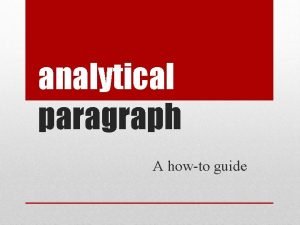
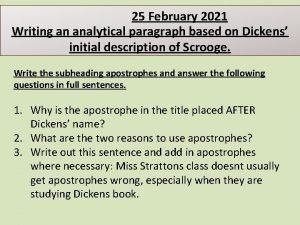
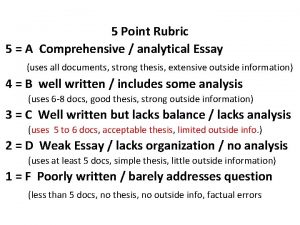
![Whose “great days [are] like ghosts gone”? Whose “great days [are] like ghosts gone”?](https://slidetodoc.com/wp-content/uploads/2020/11/2050204_75c6504015ea85c6b90e3c752477dfe7-300x225.jpg)


